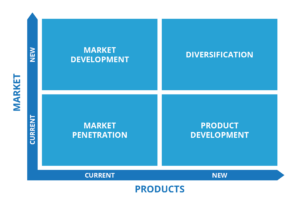
Perhaps the best way to grow your cash balance is to increase sales. So how do you increase sales? The four quadrants framework will sharpen your focus on where the easy wins are.
Previously we have spoken about cash being king and that cash is not the same as profit. What we are looking at in this article is cash growth – growth using Ansoff’s 4 quadrant framework.
Have you ever thought that you’d like to grow your business but don’t know how?
So having a framework to think about growth is a very useful tool. This quadrant is based on two key elements, the product and the customer. If you start to think about how to increase your sales, this provides a framework so you can start to sharpen the focus on where the easy wins are.
Take a look at the quadrants below. We will consider each of them in order of the likely speed to a result.

In most circumstances, the quickest cash growth gains come from the same product, same market quadrant. You already have the product and you already know the market. So, how do you get more customers from doing what you’ve always done? Can you capture their attention more than before? Focusing on this ‘market penetration’ strategy may identify quick wins.
Think about the addition of the blue stripes on the GT Falcons back in the day, and how that helped those cars fly off the lot! Do you need to repackage your product or the way you present it to the market, to differentiate it from competitor products? Or refine your offering to provide more value to the market? Could a loyalty scheme or a buy-now pay-later offer be the difference?
If you look at developing/bringing a new product into the same market, most likely that will involve leveraging existing relationships and gaining a greater ‘share of wallet’ from those existing customers. This ‘product development’ strategy has you offering more things than before but to the same market. The most successful examples make sense to the consumer. They are a logical extension of what you already do. It’s like a corner store becoming a supermarket. More things to sell to a market that you already have a deep knowledge of.
Market knowledge is often under-estimated in terms of importance. Hence why we rate this ‘market development’ or same product, new market strategy as being slightly more difficult to pull off (though it depends on the unique circumstances of your product and market). It’s why Cold Chisel struggled in the US – their brand of rock just didn’t appeal to that market. It’s why our winemakers spent so much time tweaking their reds for the Chinese market (ouch!). As you have already worked out by now, this strategy could be a geographically based market change. Or it could involve a different customer type than the customer group you currently target (think of an accounting practice deciding to target individuals, rather than business clients).
Developing a new product and take it to a new market (aka ‘diversification’) might promise great riches (and to be a serious consideration, it should) but it will take a considerable amount of time, resources and effort. Not to mention the risk that it may not be successful. It may be successful but it is not what you’d call ‘low hanging fruit’. It would need to be the culmination of a fair volume of work to verify the market exists and wants to buy the product you are developing.
Dyson are an interesting recent example of this – we always knew of them producing vacuum cleaners yet in 2016 they announced that they were developing a ‘radical and different’ electric vehicle. That program was scrapped in 2019 because after spending millions of pounds on development, the company worked out that the product would not be commercially viable.
This framework doesn’t give you the answers as to specifically what you should do, but it gives you a way to start thinking about what matters. It is a method that you can use to sharpen your focus on the issue of growth.
It enables you to contemplate where the wins are going to come from and what gives you the greatest probability of success.
If one of the objectives is to grow, obviously you will need more sales. Growth in sales is a fundamental objective.
- What’s does that look like?
- Where are they going to come from?
- What do you need to do to make that a reality?
So, if you are sitting there, grappling with how to grow your business, this is a simple but effective way to get started. The point is to sharpen the focus on what to do next.
Most importantly keep asking yourself…
What’s the shortest distance to revenue? Where is that first dollar coming from? We look at cash flow in an upcoming series of articles.
If you need help now, BridgePoint Group’s advisory services can assist you in the decision making processes leading to cash growth in your business and ultimately financial freedom.
For more information, call us on 1300 656 141, or email us at info@bridgepointgroup.com.au.
Our office is located in North Sydney.
For the latest news from BridgePoint Group follow our company’s LinkedIn page here or sign up for our informative newsletter.
Regards
The BridgePoint Group team.
